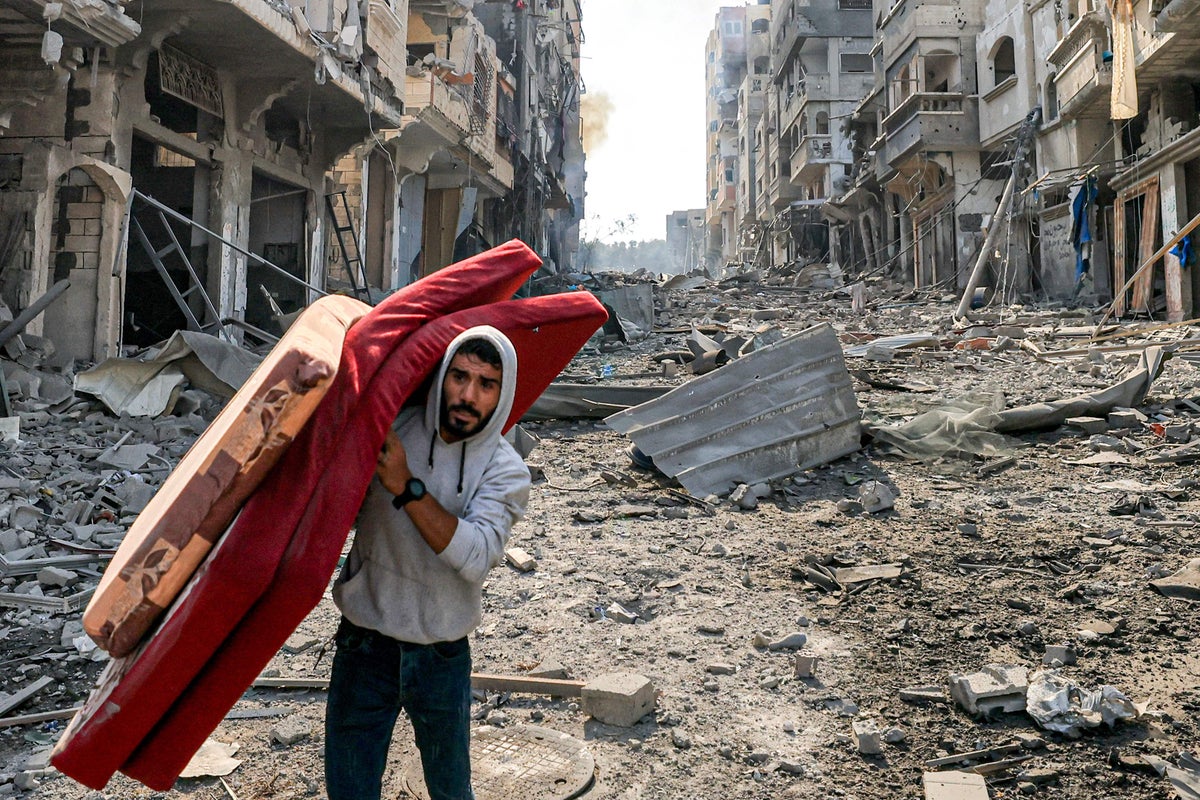
Described as “the world’s largest open-air prison” by human rights groups, the Gaza Strip is facing its biggest humanitarian crisis yet as airstrikes rain down on its civilian population.
Since the conflict began five days ago, nearly 1,000 people have been killed by Israel’s retaliatory airstrikes, while a further 5,000 have been wounded with hundreds of children and families affected.
A 25-mile long enclave which has been the subject of a blockade since 2007, more than 65 per cent of its 2.3 million inhabitants live below the poverty line, with conditions for children previously described as “hell on earth”.
With the last power plant turned off and hospitals “at capacity”, the latest “complete siege” of the strip has blocked all electricity, food and water with no escape route available for its desperate citizens.
A brief history
A narrow wedge of land on the Mediterranean Sea that had once been part of the Ottoman Empire, the Gaza Strip was controlled by Egypt for two decades after Israel declared its statehood in 1948.
However, after Israel’s victory in the 1967 Six-Day War against its Arab neighbours, it came under their control for the next 38 years.
Over this period, Israeli troops oversaw the territory and the construction of 21 Jewish settlements began, causing tension and resentment to rise between both populations.
Smoke rises from Gaza City after Israeli airstrikes decimate buildings— (Anadolu/Getty)
In 1993, a historic agreement was reached with the signing of the Oslo Accords, with Palestinians given limited control in Gaza and in the West Bank with envisaged statehood after five years. This never happened due to ongoing tensions, with Israel accusing the Palestinians of reneging on security agreements.
Facing international pressure, Israel eventually withdrew around 9,000 Israeli settlers and military personnel from the strip in 2005, leaving it to be governed by the internationally recognised Palestinian Authority.
Just one year later, Hamas led a surprising victory in the Palestinian election, and have controlled Gaza since 2007. Regarded as a terrorist organisation by the international community, Israel imposed a land, air and sea blockade which has crippled its economy.
Despite the devastating effect on Palestinian civilians and condemnation from the United Nations and human rights groups, Israel has maintained the blockade is necessary to protect their citizens from Hamas.
Can people leave and enter the Gaza strip?
Israel’s blockade has prevented people and goods from freely entering or leaving the strip, a move which has also been enforced by Egypt.
Palestinians in Gaza have been under a 16-year blockade— (AFP via Getty Images)
The Israeli government forbids Palestinians from entering or leaving Gaza “except in extremely rare cases, which include urgent, life-threatening medical conditions and a very short list of merchants”, according to B’Tselem, an Israeli human rights group.
Israelis, Jewish settlers and tourists are not subject to these restrictions and are free to travel in and out. Egypt also periodically closes its land-border crossing at Rafah, which is often the only way Palestinians in Gaza can access the rest of the world.
The International Committee of the Red Cross deems the blockade illegal and says it violates the Geneva Convention while the UN and various human rights groups consider the Gaza Strip to still be under military occupation by Israel.
Israel reserves the right to enter Gaza at will with its military and maintains a no-go buffer zone within the Gaza territory.
What are the living conditions in Gaza?
With over two million Palestinians living within roughly 140 square miles, Gaza is “one of the world’s most densely populated territories”, with half of its occupants under the age of 19.
Last year Save the Children reported that 80 per cent of Gazan children suffer from depression— (AP)
Described as an “open-air prison” by Human Rights Watch and bordered by walls and fences, conditions in Gaza have long since been difficult with 95 per cent surviving without access to clean water.
Eight recognised refugee camps span the strip with its exhausted economy struggling to create job opportunities and its population reliant on international aid.
Despite these challenges, life has continued in the besieged enclave, with a number of universities providing educational courses and markets sellings locally crafted goods. Catering to around 16,000 students, Al-Azhar University provides courses in agriculture, medical scientists and dentistry while the Al-Quds Open University operates six centres across Palestine.
A number of residential buildings have been destroyed with at least 900 Palestinians killed— (Maxar )
Recent airstrikes have targeted the Islamic University of Gaza since Saturday, with Israel describing it as a “training institution for the development and production of weapons”.
Along the coast, fishermen who are able to work within the 15 nautical mile fishing limit continue to sell their produce, while small restaurants along the coast sell fresh sardines and watermelons.
Speaing to The Independent, Dr Nathaniel George, a lecturer in Middle East Politics at SOAS University said: that a ground attack from Israel will be the “biggest and most deadly and most brutal of all the ones that have come before now.”
“2.3 million people in 140 square miles, half the population are children, and they’re just carpet bombing,” he said. “You have to imagine that half the population of the strip are children under the age of 18. For a child that has grown up mostly in this period of intense blockade by Israel and Egypt and the peace process is completely shutting down.”







